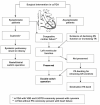Pathogenesis and Surgical Treatment of Congenitally Corrected Transposition of the Great Arteries (ccTGA): Part III
- PMID: 39336948
- PMCID: PMC11432588
- DOI: 10.3390/jcm13185461
Pathogenesis and Surgical Treatment of Congenitally Corrected Transposition of the Great Arteries (ccTGA): Part III
Abstract
Congenitally corrected transposition of the great arteries (ccTGA) is an infrequent and complex congenital malformation, which accounts for approximately 0.5% of all congenital heart defects. This defect is characterized by both atrioventricular and ventriculoarterial discordance, with the right atrium connected to the morphological left ventricle (LV), ejecting blood into the pulmonary artery, while the left atrium is connected to the morphological right ventricle (RV), ejecting blood into the aorta. Due to this double discordance, the blood flow is physiologically normal. Most patients have coexisting cardiac abnormalities that require further treatment. Untreated natural course is often associated with progressive failure of the systemic right ventricle (RV), tricuspid valve (TV) regurgitation, arrhythmia, and sudden cardiac death, which occurs in approximately 50% of patients below the age of 40. Some patients do not require surgical intervention, but most undergo physiological repair leaving the right ventricle in the systemic position, anatomical surgery which restores the left ventricle as the systemic ventricle, or univentricular palliation. Various types of anatomic repair have been proposed for the correction of double discordance. They combine an atrial switch (Senning or Mustard procedure) with either an arterial switch operation (ASO) as a double-switch operation or, in the cases of relevant left ventricular outflow tract obstruction (LVOTO) and ventricular septal defect (VSD), intra-ventricular rerouting by a Rastelli procedure. More recently implemented procedures, variations of aortic root translocations such as the Nikaidoh or the half-turned truncal switch/en bloc rotation, improve left ventricular outflow tract (LVOT) geometry and supposedly prevent the recurrence of LVOTO. Anatomic repair for congenitally corrected ccTGA has been shown to enable patients to survive into adulthood.
Keywords: congenitally corrected transposition; diagnosis; discordant atrioventricular connections; discordant ventriculoarterial connections; operation procedures.
Conflict of interest statement
The authors declare that they have no conflicts of interest.
Figures







References
-
- Nikaidoh H. Aortic translocation and biventricular outflow tract reconstruction. A new surgical repair for transposition of the great arteries associated with ventricular septal defect and pulmonary stenosis. J. Thorac. Cardiovasc. Surg. 1984;88:365–372. doi: 10.1016/S0022-5223(19)38323-0. - DOI - PubMed
-
- Yamagishi M., Shuntoh K., Matsushita T., Fujiwara K., Shinkawa T., Miyazaki T., Kitamura N. Half-turned truncal switch operation for complete transposition of the great arteries with ventricular septal defect and pulmonary stenosis. J. Thorac. Cardiovasc. Surg. 2003;125:966–968. doi: 10.1067/mtc.2003.33. - DOI - PubMed
Publication types
Grants and funding
LinkOut - more resources
Full Text Sources
Research Materials

